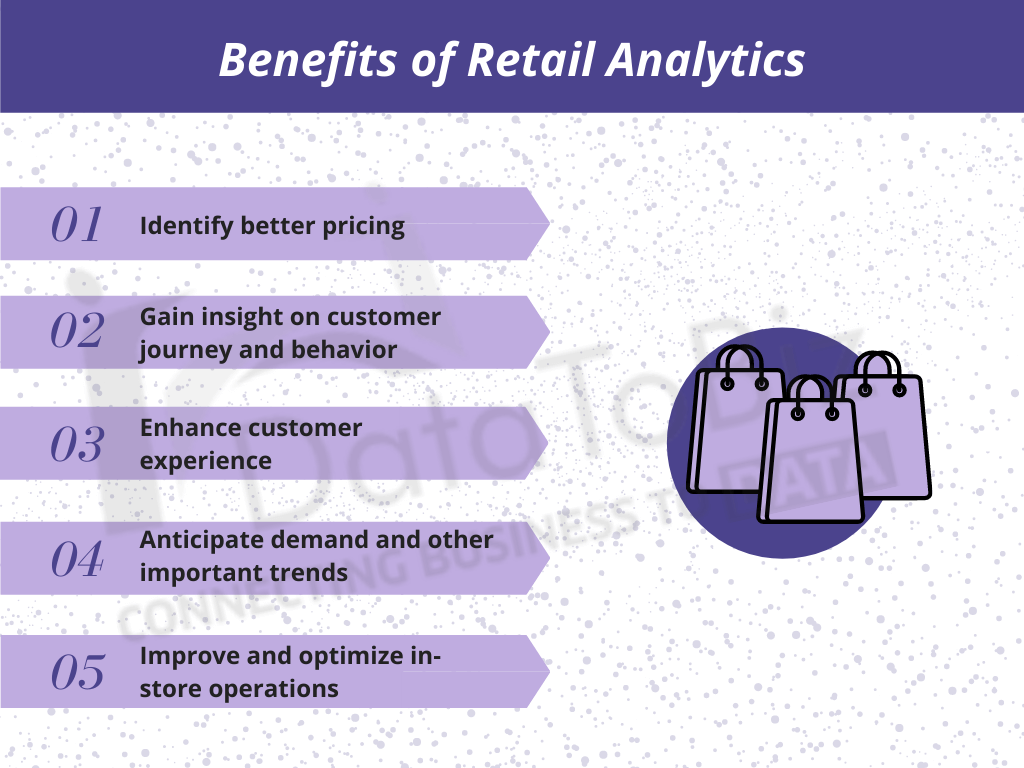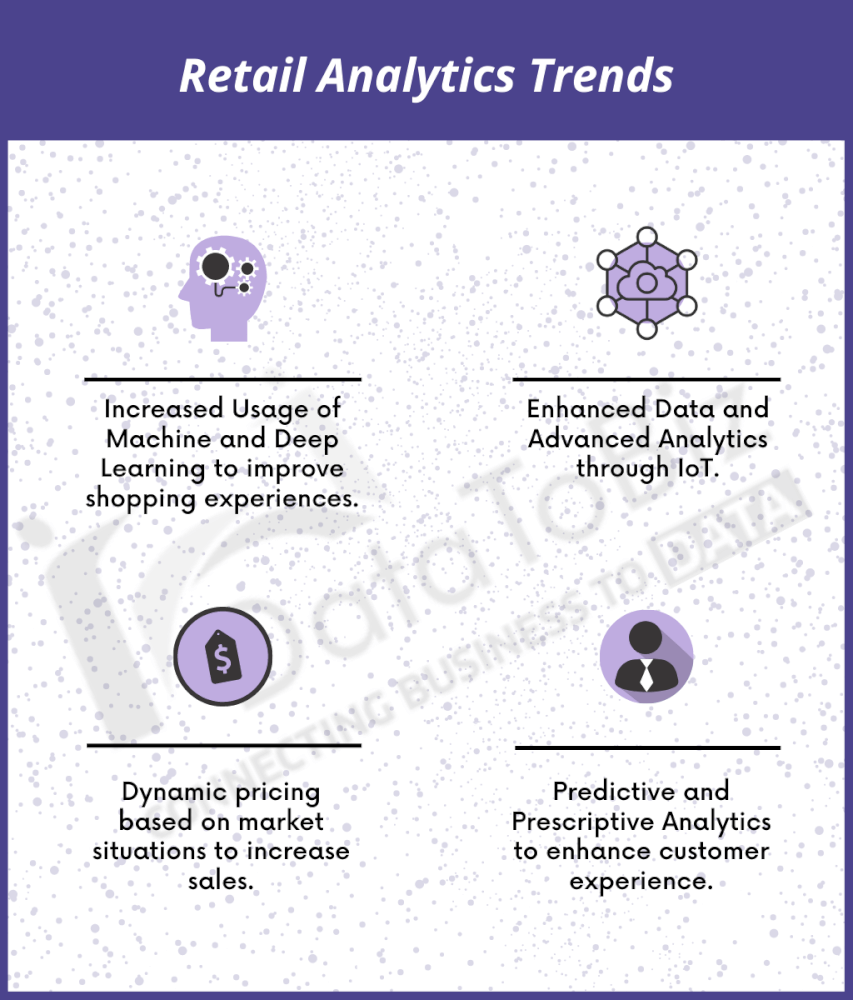What is one of the most important factors a retailer should always monitor? It’s the price of products they sell. We all know that the selling price of a product is pre-fixed. But that doesn’t stop some retailers from offering discounts and giveaways.
In fact, customers today expect you to offer products at competitive prices. With so many stores mushrooming (online and offline), it has become necessary to have a flexible pricing policy. Guesswork won’t help you in the long run. It is a sure way to end up in losses.
Why not give a shot to analytics for retail price optimization?
In simple words, analyzing retail business & customer behavior data to help retailers make better decisions is known as retail analytics. Of course, it is hardly that easy in real life. Retail analytics is the process of using AI tools to collect and analyze historical and real-time data to derive in-depth insights. It allows you to make better decisions based on these insights.
This will be a win-win situation for you and your customers.

Before we read more about analytics for retail price optimization, let us answer the following questions. These are some key factors that you must consider as a part of your retail analytics.
How willing are Customers to Pay for a Product?
Also known as price sensitivity, this factor deals with the maximum amount a customer would pay for a product. Unless you know this, you cannot make adjustments to the prices of products you sell in your retail stores.
What is the Average Revenue Generated per User?
How much does each customer contribute to your revenue each month? Knowing the answer to this question will help you understand who your most valued customers are and which products they are buying.
What Makes a Product Famous Among the Customers (Product Value)?
It can also be termed as feature value analysis, where you try to identify the most liked and least liked features of a product. Depending on the number of features/ aspects customers like or prefer in a product, they will fix a price for it in their minds. If you set your selling price over that amount, it will affect your sales as they may not wish to pay as much.
How do Customer Acquisition Costs and Customer Lifetime Value Affect Your Pricing Decisions?
You need to know how much you can invest in a customer. There is no point in running an extensive campaign if the customer doesn’t buy from your retail stores, right?
Getting faster returns is the dream of every retailer. Who would want to wait for months and years as the interest accumulates and reduces the profit margin? Computer vision solutions for retail allow you to come up with a pricing policy that can be changed in real-time. Each time you adjust your short-term goals, you can tweak the prices accordingly. That too, without worrying whether the customer will pay as much or not.
A study by PwC found that 60% of the customers decide whether to buy a product or not solely based on its price. Fixing the price without knowing how things stand could lead to losses instead of increasing ROI.
It is eventually up to the customers to buy a product, isn’t it? Even the best discount offers don’t result in sales at times. This could be because-
How can you make sure such mistakes don’t happen? By using retail analytics to get insights about customers’ purchase behavior and interests. What drivers influence customers to buy a product? The answer to this question can help you optimize the price to increase sales and profits.
Who said automation is not meant for retailers? Why spend your precious time calculating and analyzing the market trends, measuring the price changes, and monitoring customer demands? Let technology do it on your behalf.
It would also reduce the risk of human error and give you more time to focus on implementing the pricing and promotional strategies. Machine learning algorithms can help automate pricing. It can be integrated with other retail applications you use to streamline your business operations. You can stay up to date with the latest changes in the market (check the next point).
A successful retailer is the one who can make fast and accurate pricing changes in real-time. Effectively managing both offline and online sales is becoming more of a necessity in recent times.
When you know that the demand for a product will increase or decrease in the coming days, you can plan your pricing strategies to attract more customers and increase your return on investment.
The feedback here comes from the retail analytics software you use. The regular reports generated by the software will tell you whether the current pricing plan is effective or if changes have to be made. Real-time insights are derived from the latest information available.
This helps you make quick changes to the prices and adjust them immediately to suit the customers’ demands. Instead of taking feedback through surveys, you can get the required reports from the software. The constant feedback will keep you at the top of your game and ahead of your competition.
A wrong decision could prove to be very costly for a retailer. While gut feeling cannot be ignored, relying entirely on it is a risky bargain. At the same time, having volumes of raw data is of no use if you cannot process data to derive insights.
You will know which customer group to target with your promotional plan. The decisions you make will be based on accurate and reliable insights rather than guesswork.
Data includes text, images, videos, infographics, and more. The use of image analysis in retail analytics helps you identify and process the pictures on the internet to understand customers’ reactions to a product. Optimizing the price is done to attract more customers and increase returns, isn’t it? For your pricing plan to be successful, you will need to work on enhancing customer satisfaction.
We know that customers are likely to stay loyal to a retailer if they are happy with the product pricing and other services. Retail analytics help you find ways to make customers happy and prevent them from drifting to another retailer. Your price plan is a vital part of optimizing the customer experience.
Having excess inventory no one wants to buy is as bad as running out of stock when there is excess demand in the market. As a retailer, your constant focus would on avoiding either of these from happening, right?

Retail analytics helps you avoid such situations from affecting your business. The insights derived from real-time data will keep you updated about the current and future trends in the market. When it is combined with historical data, you will have enough information to have firm control over the inventory levels in your warehouse.
One point retailers tend to miss is the influence of domain context on the insights. The data you’ve processed is reliable only when it has been analyzed concerning the parameters belonging to the domain.
For example, you cannot follow the same pricing policy for spices and biscuits. The usage, requirements, target customers, and the frequency of purchase are different from both. Retail analytics lets you use the domain knowledge for each product to come up with a comprehensive pricing strategy. This will lead to better success in implementing the promotions and increase your ROI.
With computer vision for retail AI and tools to support your business operations, you will not miss out on chances to make minor adjustments at the point of sale. While it may not seem like a big thing, these tweaks could tip the scales in your favor by limiting price reduction beyond a point and identifying ways to counterbalance the decrease in returns.
You also need to keep your marketing costs under control so that you don’t end up spending more on promoting the product compared to what you get when you sell them. Insights from retail analytics help you make more profit at PoS by balancing the promotional costs and optimizing the product prices.
Scenario modeling is the process of testing how effective a pricing plan will be in the given set of conditions. This will help you get a better idea about how customers will react to the changes in price and how you can increase your profits.
How can a retailer generate more revenue in less time using retail analytics? By focusing on products with higher demand and targeting customers with similar purchase history. You will need to correlate between the products and customers to ensure that you have underpriced some products or overpriced a few others. The technology of Computer vision in retail aids in identifying and plugging such gaps in your pricing policy.
You will know when and how to take advantage of a sudden rise in demand for a product or clear out the pending stock that’s been sitting on the shelves for too long. You can increase your revenue in a short time by fixing the gaps in your pricing policy.
Conclusion
If you want your retail business to flourish and expand, you will need to invest in the latest artificial intelligence technology, such as retail analytics. The tools will streamline your business operations, identify the gaps, capture real-time customer insights, and provide detailed reports based on processed data.
Perks are on a heavier side with analytics for retail price optimization systems.
There is little point in collecting data if it is not put to use, isn’t it? Let retail analytics take care of processing the data on your behalf and optimize the prices to increase your returns. Keep your customers happy and stay ahead of your competitors.
You must be logged in to post a comment.

It¦s really a nice and helpful piece of info. I am glad that you just shared this useful information with us. Please keep us up to date like this.